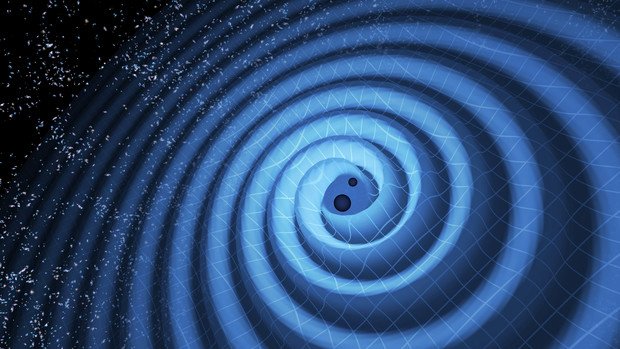This text is more or less a translation of an article that I wrote for a French popular scientific magazine called La Recherche: https://steemit.com/fr/@mlilom/gw170817-la-propagation-des-ondes-gravitationnelles-versus-electromagnetique
Gravitational waves travel at the speed of light
Einstein’s general relativity theory predicts that both gravitational and electromagnetic waves propagate in exactly the same way.
Thanks to the detection of the gravitational waves due to the merging of two neutron stars – an event named GW170817, and which happened at more than 80 million light-years away – and thanks to to the (almost) simultaneous detection of one of its electromagnetic counterparts – a short gamma-ray burst detected with the satellites Fermi and INTEGRAL – one was, at last, able to accurately test this crucial prediction.
Before this event, the speed of gravitational waves was inferred by comparing the arrival times of a gravitational wave at remote gravitational waves detectors. However, notably because of uncertainties related to the poorly known incident direction of the detected gravitational waves, the constraint on the speed of gravitational waves was rather weak: between 0.55 and 1.42 times the speed of light [Cornish et al. 2017].
But thanks to the very small delay between the detections of the gravitational and gamma waves – about 1.7 seconds – and the very long propagation time of both signals – more than 80 million years – one can now say that both speeds are the same with an exquisite accuracy of 15 orders of magnitude. It means that if the two speeds do differ, then it must be by less than a few 0.000 000 000 000 1 % [Abbott et al. 2017]. The main remaining uncertainty comes from the fact that we do not know for sure the delay between the two emissions: gravitational waves on one hand and gamma rays on the other hand. Hence, one has to take into account several astrophysical models of gamma ray burst, which predict various delays between the two emissions. If the delay between the two emissions is exactly 1.7 seconds, then it would mean that the two waves propagate exactly at the same speed. But if gamma rays are emitted more (less) than 1.7 s after the gravitational waves, then it would mean that electromagnetic waves propagate faster (more slowly) than gravitational waves – although by a tiny amount, since we now know that the two speeds are the same up to a few 10^-13 %. This explains why they are an upper and a lower limit in the constraint given in the discovery paper [Abbott et al. 2017] – one limit corresponds to the case in which light is faster than gravitational waves, and the other limit is the opposite situation.
More than just checking a prediction of general relativity, this new result allows to constrain several alternative theories of gravitation, which predict a spontaneous breaking of the Lorentz invariance with very low (although unpredictable) amplitudes. The phenomenon would be somehow similar to the Higgs mechanism, but with other – often more complex – fields. Such a scenario is essentially motivated by theories that aim to describe gravity within the realm of quantum field theory, while it is often thought that general relativity is somehow incompatible with quantum field theory – even though this is not necessarily true, see for instance the recent article from Sabine Hossenfleder in Quanta magazine.
Another aspect that is tested by these new measurements is a form of the equivalence principle, which roughly states that all objects fall equivalently, regardless of their kind. (For instance, an object made of gold falls like an object made of wood). Indeed, general relativity predicts that gravitational and electromagnetic waves are equally affected by surrounding gravitational fields. In some sense, it is like saying that both gravitational and electromagnetic waves fall in exactly the same way in a given gravitational field. In particular, GW170817 allows to test a phenomenon called the Shapiro delay. This effect tells that a wave that is propagating in a gravitational field is delayed compared to a wave that would not be propagating in a gravitational field. But the two waves (gravitational and electromagnetic) reached our detectors at roughly the same time, while the Shapiro effect from the gravitational potential of the Milky Way alone should lead to a delay of more than a week. Besides, since the Shapiro delay has been accurately measured in the Solar system for electromagnetic waves [Bertotti et al. 2003], we now can tell that this effect is indeed the same for both gravitational and electromagnetic waves at the 10^-6 level of accuracy (i.e. 0.000 1%) [Abbott et al. 2017]. As a consequence, several alternative theories of gravitation – aimed at explaining dark matter and/or dark energy with some kind of modifications of the laws of gravitation – are now ruled out, or are much closer to be than what was previously thought.

[Image credits: LIGO]
Very nice! At some point I wanted to write about that, but I was a bit pushed for time. Thanks a lot for this very nice article (also the French version).
Thanks a lot @lemouth!
Hi, I found some acronyms/abbreviations in this post. This is how they expand:
Here is a much better article on the subject, written by another astrophysicist: https://cosmosmagazine.com/space/how-colliding-neutron-stars-proved-all-are-equal-before-the-law-of-gravity